Ways To Use A Bandana For Bushcraft
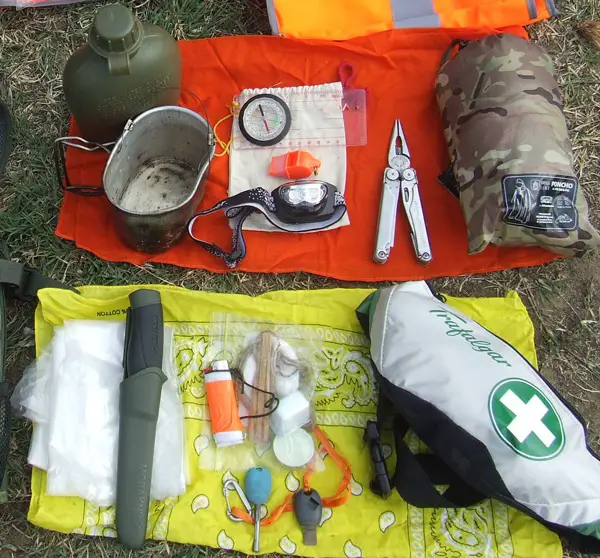
The bandana is a useful bit of kit for bushcraft and camping, or even include it as part of a survival gear. Although a simple bit of cloth, the bandana has a multitude of uses for the outdoors.
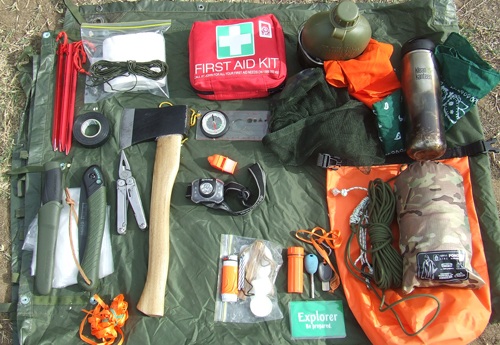
As above: As part of bushcraft and survival gear is two bandanas. Top right in the photo, two bandana’s (Orange and green.)
Here are over twenty nine ways to use the bandana for bushcraft.
1. Pre-filtering for collecting water.
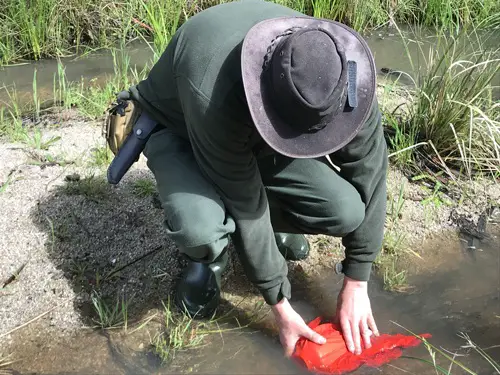
Use the bandana as a pre-filter to get rid of some of the muddy water and debris while collecting water. It also helps remove some nasty bugs, as these can cling on to dirt, faeces, debris etc. in the water.
Fold over the bandana a few times and place it over the container opening. Pour the cloudy water onto the bandana so it will drip through into an unfilled container.
For streams or water holes place the bandana over the container opening and place into the water filling it up. If you have trouble holding the cloth over the container while trying to fill it up, tie some cordage over the bandanna, securing it to the container.
While pre-filtering with a cloth like a bandanna (Or use a hat, or article of clothing.) helps reduce the turbidity of the water, of course you still will need to boil the water or use a chemical treatment to kill the germs as the last stage. (With some new bandanas the ink can run, so wash it before you take it in the field and use it for any water collection.)
A pre-filter like a cloth also saves resources if you do then want to use a dedicated secondary type filter like a Sayer-mini, etc. You are not blocking up the filter with course sediment and you are extending the life of the water filter.
2. Bandana for handling hot cooking items.
A bandana is very handy item when camp cooking or practicing bushcraft skills. Use it as a tea towel to dry cooking utensils. (Or the lazy way is too place the utensil near the fire and dry. Or just wave it back and forwards to air dry it.)
Use it when you have to hold the hot cooking items, like pots, etc. or take them off the fire. Or wipe down your hands or food items. Also the bandana can be used as a strainer for bush cooking. Use it to strain pasta, pine needle leaves, etc.
3. Char cloth.
While we don’t like ripping off strips of our clothing in an emergency for fire making or char cloth, (As clothes are a primary shelter for protecting us from the elements.) cutting up a bandana, might be less destructive. 100% cotton is going to work best.
Or better yet, use natural materials to char. Or ignite part of the bandana as is, for immediate fire lighting tinder.
4. Silence noisy Items.
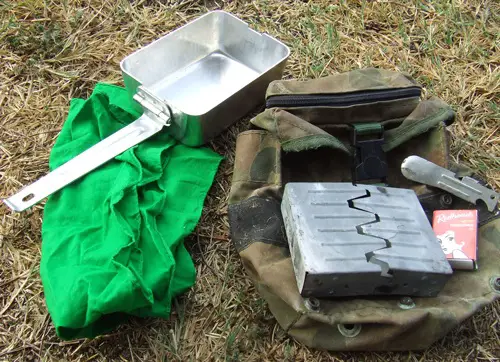
For hunting, tactical situations or even just observing nature, having quite gear is a must. Use the bandana to stop items in your back pack rattling by wrapping them up. Items like the stainless steel water bottle, hexamine stove or other cooking utensils can be noisy. A cloth placed around gear or in between help silence them.
5. Protect items.
Use the bandana to help protect and cushion electronic items or easy to damage items. Such as wrapping up a GPS, to protect the screen from scratching while in you backpack or bum bag. Of course a properly designed padded bag for the device is better, but for an additional layer, the cloth works okay in a pinch.
Other items like a headlamp, magnifying glass for fire lighting, smartphone, signalling mirror, cameras, compass, could also be wrapped up to protect it better while transporting them.
6. Collecting dew and water.
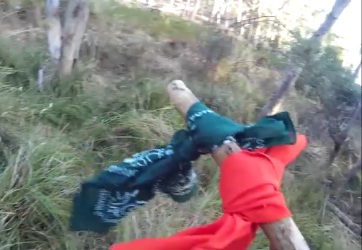
Collect the dew early in the morning or preferably on dusk, while the grasses are still wet from the morning dew. Tie the bandana (Or article of clothing.) on around your ankles or around the shoelaces and walk though wet grasses and shrubs. (Make sure you don’t go near any toxic plants.)
When the bandana or rag has soaked up the dew, wring out the water into a container. While a lot of grasses should ideally be safe to collect and drink initially, dirt, bird poo and animals contacting the grasses may carry diseases, parasites, etc. So it is probably always better to treat or boil the drinking water first, before consuming.
An additional way to utilize the bandana is to tie it on the bottom of a stick or walking stick. (Or two bandanas.) Walk through the grass and use it to mop up the morning dew.
Another method for using the bandana (Or a shoe lace or piece of para cord.) for collecting water is to place it in the cracks and small crevices on cliff faces and large rocks that have moisture or water running down it.
The cotton bandana will wick-up the water and eventually saturate it, until the end of the bandana starts dripping water. Place a container directly below the bandana to collect the dripping water.
The bandana can also be lowered into small cracks between rocks or hard to get to places that might have pools of water in them. Tie some cord on it and poke it down with a stick. Let the cloth soak up the water then pull it up and rinse out the collected water into a container.
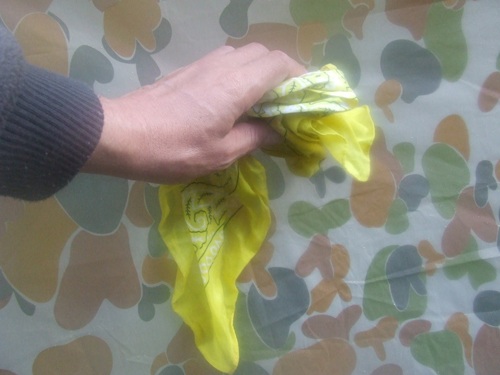
The bandana can also be used as a cloth to wipe the overnight dew from the tent, tarp, rock faces or even a vehicle. (Be careful wiping from the duco and windscreens of cars as the car can collect dirt, bird faeces, grime and nasty vehicle exhaust fumes.
Also detergents or chemicals used to wash the vehicle may still present.) (Once again wash properly before taking it into the bush so the ink doesn’t run from the cloth and ruin your water.)
7. Use the bandana for a signalling device, emergency flag or location marker.
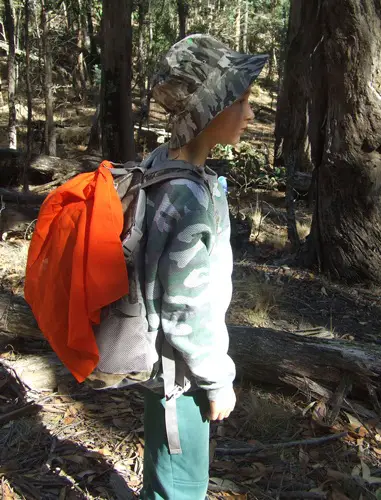
A bright colored bandana, like fluorescent orange, yellow, pink, etc. are good makeshift signalling and emergency markers. If you are lost when hiking, most times the best thing you can is stop where you are, think and plan. If you do have to self-rescue and keep walking, then tie the bright bandana cloth on your hat or top of your back pack to help rescuers visually locate you.
Tie another bright bandana on a walking stick or pole. This can then be raised in the air with the bandana tied on the end like a flag and waived about when a rescue team is spotted.
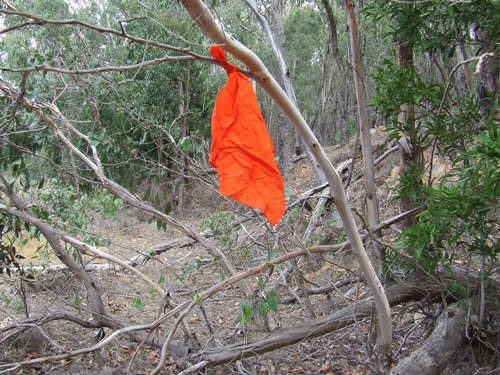
If lost and you need to sit or lie down and rest, but worried that the search and rescue party won’t see you, tie the bandana on a tree limb above or close by where you are resting.
Or drive a long stick into the ground and tie the bandana on, like a flag pole. (The orange or yellow colored bandana may blend in in some woodland environments like an area with a lot of orange autumn/fall leaves. A bright or fluro blue color might work best in some surrounds.)
For group camping or inexperienced campers, tying a bright colored bandana or two high up, in your base camp might be a good idea. It is common for people to get lost very close to camp, just collecting firewood, going to the bush toilet or looking at nature. (A rule for the children when camping might be, if they are out playing in the woods near to camp, is if they can’t see the orange base camp cloth/flag, then stop moving immediately and call or whistle for help.)
For navigating on a bearing, but you then want to go off the bearing to collect some drinking water or investigate an area, tie the bandana on a branch high up.
Once you have collected the water or looked at the item that has caught your eye, then simply go back to the location where your bandana marker is, untie the marker then continue on your compass bearing. While not ideal, the bandana might be cut into strips and used as a breadcrumb type of marker when lost. For tracking wounded game, tie the bandana on a tree limb above the last found blood trail. (Or flagging tape.)
If two bandanas are used, rotate them. Look around the area until a further blood trail is found, and tie a second bandana or marker. Although time consuming, retrieve the first bandana. This also helps getting a line of sight from the first bandana to second one, to where the animal roughly might be heading.
Another option is to use a bandana tied on a pointy stick and push it in the ground near the last blood trail.
When quail or game bird shooting in thick foliage or heavy stubble paddock, I normally have a bright colored orange hat. (Or use a bright colored bandana tied onto your day pack.) When you see the bird go down, walk to the area where you think the downed quail / game bird is and place the hat / marker there.
You can then do a small circle around the maker, spiraling outwards from the location marker until you find the downed game bird. (It is easy to slowly move away from the immediate area where you think the game bird went down while you are looking on the ground and end up nowhere near the location the bird is.)
Use a bandana to mark the location close to the start of the trap line. (Fluro reflective tape tied around a branch is handy at night time. In thick bush and unfamiliar areas, it is easy to waste time searching for the start of the traps. (When rabbit trapping, my father used to draw an arrow in the dirt to mark the direction of the next traps.
Sometimes marking a number as well, close to the arrow mark. As it is easy to forget how many traps you have checked, especially at night time wondering around in the bush.) If you have several water transpiration bags out collecting water, use a bandana to mark the first one, (Ideally you have the transpiration bags close to camp, but sometimes the clear bags are hard to see, or the ideal trees aren’t ideally close to camp.)
The bandana can be used to tie on guy lines or ridge lines to help people around camp be aware of the rope and not walk into it.
8. Article of clothing or hat.
Besides using the bandana as a do-rag, it can used for other clothing uses. Use as a scarf or sweat band. Or place on the back of the hat to protect the back of the neck like a foreign legion hat For hot climates when hiking, wet the bandana (Or hat.) and use it as a cool compress or wring out the water over your head to help cool you down.
9. Knee pad.
Kneeling down trying to light a fire or doing fold the bandana over and use it to kneel on to cushion your knees against sticks etc. on the ground.
10. Veil.
A dull color bandana can be used as veil / face mask to help eliminate the shine off the face when hunting or in a tactical situation. (Or army scrim scarf, or use charcoal, although messy.) This is especially important as the head moves around often. The veil can also help with annoying flies, insects or mosquitoes on your head.
The bandana face mask is also useful for reducing dust and sand in strong winds.
11. Preparing tinder.
When preparing feather sticks, you can lose a lot of wood shavings that could be useful for tinder. Place the cloth bandana under when making a feather stick to collect the pieces/shavings that fall off.
Likewise when sawing or scraping fatwood or dry wood for bushcraft or woodwork skills collect the sawdust (Depending on wood type.) this can be used for tinder or helping the fire ignite. Place the bandana under the work area to collect the scrapings or saw dust.
If it is a windy, place two, three or four branches or rocks on the edges of the bandana for collecting shavings and saw dust when preparing fire.
The bandana can be wrapped around bark and grasses to baton or pummel down the material for fire lighting. The bandana helps keep the fine tinder materials from blowing away when processing it. Don’t go overboard and shred the bandana though.
12. Collecting edibles.
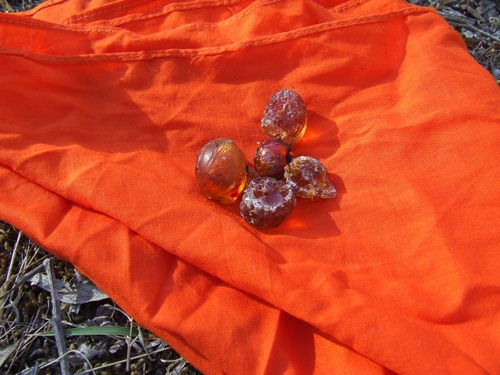
(Above image is acacia gum or sap. The gum can be sucked on like a lolly or candy, or melted down in a hot drink. The taste is similar to honey, but not as sweet.)
Use as the bandana as a container / bag to collect wild berries, seeds, insects and edible plants when foraging.
Tie the four corners up and you have a makeshift cloth bag. For collecting certain seeds or some fruits, the bandana can be placed on the ground, like a groundsheet and the plants or tree shaken.
13. Wiping lenses.
While not as ideal as a microfiber cloth, if you haven’t got a lens wipe cloth, a clean bandana can be used. Carefully wipe glasses, smart phone screens, survival mirrors or camera lenses spotless.
14. Gathering and drying out tinder.
Use the bandana as a bag to collect tinder or kindling. If the tinder is a bit damp, place it in the bandana cloth bag and put it close to the body to warm it and dry it out. Such as placing the bandana under a jacket or shirt. (If exerting the body too much you may sweat and the cloth bag can become wet, so it can be a fine line between drying out, and making it damper.)
Another method for drying out the tinder is to hang the bandana bag under a tarp or shelter or under a tree, so the air can circulate around the tinder and dry it more.
15. The bandana for handling fish.
The bandanna can help hold and handle slippery fish or eels when caught, to get the hook out of the fish or process. The cloth also helps keep some of the fish’s spines at bay when handling it. (I have heard of covering up bigger fish eyes with a cloth to keep it calmer. So I suppose you could use a bandana for that as well.)
16. Burley or chum bag.
Place some baitfish, crustaceans, and shellfish in the bandana. Tie up the corners or wrap around some cordage and tie a longer piece of cord to that. Mash up the bait, place in the water and you have a mini chum or burley bag. The bag will let through various smells of blood to attract fish for spearing, fishing or netting.
To secure the bag, (Depending whether in freshwater or saltwater and the surrounds.) tie the rope to a limb in freshwater, or use a steak in the sand or tied to a rock. While a string bag / net will let more pieces and smell into the water, the good thing about this bag is the smaller baitfish wont steal pieces of the chum.
In a survival situation, offal and off cuts can also be used for an attractant.
17. Bandana strips for a fishing lure.
For freshwater and saltwater fishing the bandana might be able to help. Cut some threads or strips of the bandana cloth and tie onto your hook to make a streamer, lure or fly. Mix in some thin strips of tin foil, or feathers and you have an attractor. Use the thread from the bandana to help tie the small strips to the fish hook.
The action of the current, waves can move the lure about, making it look like prey to the fish. For a survival situation a trotline, (long line), bank line (springer poles) with multiple hooks will increase your chances. Most times natural bait might will be the best for catching fish, but if you are short of bait, a bandana lure is better than nothing.
18. Water collection from saltwater fish.
In a survival situation you can collect water from saltwater fish. (Not poisonous fish.)
Cut the fish up into cubes / fillets and placing them into a bandana and wringing them out you can get some water from the fish cubes. Don’t’ forget to eat the fishes eyeball……, yum.
19. Bush Hygiene.
Outdoor activities can get a bit hot, dirty and dare I say smelly. A cotton bandana can be used as a wash rag or hygiene cloth. (A few plants can be used to help get some soap lather, like the Yucca plant.)
A little bit of warm water on the rag and you have a refreshing wash cloth. Face, armpits and groin in that order is the way to go.
20. Toilet paper.
Run out of toilet paper and no natural (Or no friendly, leaves, moss, smooth bark and stones.) types of toilet paper about, the bandana might come to the rescue. It can always be washed out again. Or for the squeamish one time emergency, the used bandana can be burnt or buried.
21. First Aid.
The bandana has multiple uses for first aid. For open cuts, place the folded clean cloth immediately on the wound and hold firmly to help stop the bleeding.
Use two bandanas tied together and fold one into a triangle and use it for an arm sling.
A bandana can be wrapped around a wound dressing bandage to help hold it in place. Combined with a stick, the bandana can be used by experienced first- aid people as a tourniquet. (Or belt.)
An eye patch or dressing over the eye is also another first aid application for the bandanna. The bandana can also be used as a splint for a broken finger.
If one, two or three compression bandages are used for a snake bite or a broken leg, use some bandanas to tie a stick, (Or use an arrow/s. With the sharp broadhead point removed of course.) for a splint to help stabilize the limb from movement.
22. Cordage.
For use as cordage in an emergency, twist and tie the bandana to secure items, like tool slings, shelter building, etc.
It can also be used to help make a light load bearing tripod, such as a ridge-line for a tarp shelter.
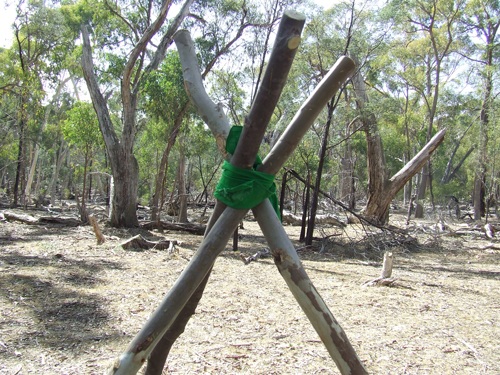
23. Tactical light.
In a tactical situation and need to put your torch on, but don’t want to emit too much light, place a bandana over the light source to diffuse it.
Use a rubber band or tie some cordage to secure the cloth around the torch. This method can help save a bit of your night vision as well if the torch or headlamp is too bright. (Or close one eye, but this makes it harder to read maps and navigate around.)
Red and green filters have been commonly used on torches for military use to help save the night vision, but if you don’t have them, the bandana works okay.
Check out Flashlights For The Outdoors for camping use.
24. Throw line.
Help throw a line over a tree limb for things like a hoist for processing deer or a bear bag or tarp. Place a rock in the bandana and tie it up and attach para cord or similar to it. Now you have a weighted object that can attach a throw line easily. (Or tie a heaving line knot, which uses the bundled knot of the rope as the weight.)
25. Gear loft.
For hammock or tarp camping, use the bandana to make a temporary bag or loft and tie on to a ridge-line, store your smart phone or keys, etc. close by. (Thank you to Craig Caudill from the YouTube channel Omega Gear for this idea.)
26. Extra padding.
Use the bandana to use as extra padding to place around rubbing back pack straps or sore spots.
To help prop up a tarp shelter, place a folded bandana on the end of a stick, to stop the stick ripping the tarp.
Wrap the bandana around a walking stick or hiking pole, so the handle is more comfortable.
The bamboo fire saw for fire making can be challenging to use. A long bamboo piece (Hearth board.) is braced against placed one on the hip or chest. This can be uncomfortable as it digs into your body. (The other end in the dirt or against a tree.) To make it more tolerable fold a bandana up and place it between the end of the bamboo piece and your body. (Another option is to use a short bamboo piece cut in half and place it across the body.
The long bamboo length is braced against the short flat piece for padding against the body. Or place the heart board against your belt.)
27. Working on delicate items.
Working on small items like small fishing hooks, swivels, springs, small nuts on bow sights, archery release devices, rifle sights, scope mounts or even camera equipment like micro SD cards, can be tricky. If they fall on the ground into the leaf litter they can be impossible to find. A simple solution is to place a bandana down (Or use your hat.) underneath delicate items while working on them.
Place a rock or stick on the cloth so it doesn’t blow away if windy.
28. Wipe down equipment or keep items clean.
Use the cloth to clean and oil knife blades, firearms, axes, etc. For firearms you can use the bandana as a pull through to clean the barrel. Attach cordage to the bandana to pull it through. (Depending on equipment to clean, protect or maintain, use bees wax or fats as alternative to oils.)
Keep items clean with the bandana. Cooking utensils can easily get covered in soot from the fire. Wrapping the item up (Or storing in a dry bag, stuff sack or ditty bags.) once cooled, it can be placed back into the pack without getting the soot on other items in your kit.
29. Carrying water bags.
I normally carry a couple of rolled up 1 litre (About a Quart.) plastic bags for extra water containers. When filled up with water, some of these bags are fragile. The bandana wrapped around the water bags protects them more from punctures as well as a carry bag.
Conclusion.
For bushcraft the bandana is lightweight, compact and can be used in a variety of situations. Whether you have one or two in your backpack, in an urban survival kit BOB (Bug Out Bag) or even used as a simple old fashioned handkerchief for your EDC kit, (Everyday carry.) the bandana is versatile.
